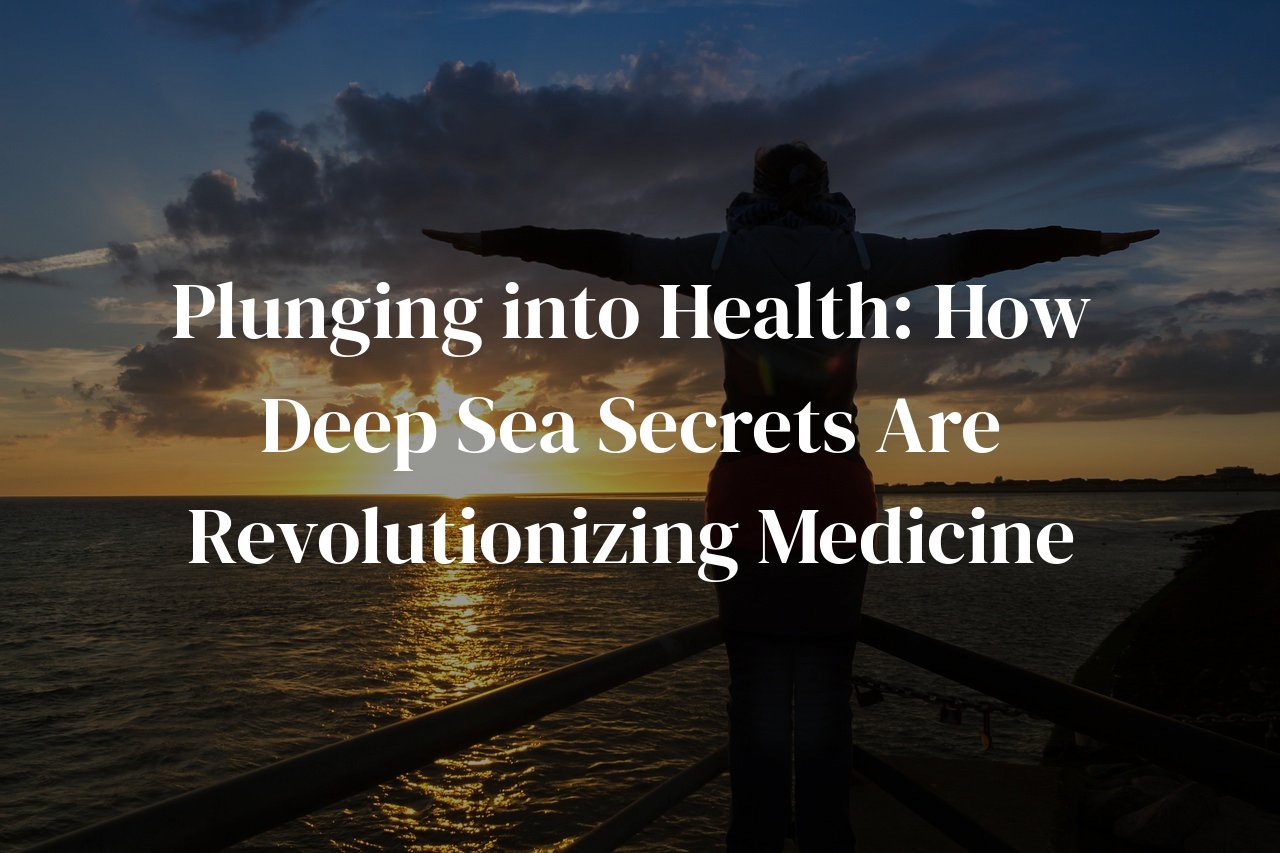
Embark on an aquatic odyssey as we delve into the depths of the ocean, where enigmatic creatures and unseen biodiversity harbor groundbreaking medical potential. This expedition will not just illuminate the hidden treasures of the deep, but will also shed light on how these discoveries are leading to novel treatments and enhancing our understanding of human health. As we unravel the ties between deep sea exploration and medical science, you, as a reader, will encounter the untapped resource beneath the waves that may hold the key to future health innovations and therapeutic breakthroughs.
Table of Contents
Diving for Drugs: Pharmaceutical Treasures from the Abyss
As someone deeply fascinated by the enigmatic deep blue, I’ve witnessed firsthand the incredible potential that the uncharted territories of the deep sea hold for modern medicine. Plunging into the abyss, researchers are discovering organisms with exceptional biochemical compounds that are no less than treasure troves for pharmaceutical development. My journey into the depths has revealed organisms that, due to extreme environments, produce unique chemicals which are leading to groundbreaking treatments.
One of the most significant discoveries has been the marine cone snail, whose venom contains potent compounds that have become pivotal in pain management. As I recall the thrill of encountering these seemingly innocuous creatures, it’s astonishing how their venom – which they use to paralyze prey – has been transformed into a powerful analgesic, far more effective than morphine, yet without its addictive side effects. This compound, Ziconotide, has been a ray of hope for chronic pain sufferers.
My explorations have also introduced me to the bizarre yet alluring world of deep-sea sponges. Researchers have extracted from these sponges novel anti-cancer agents, one of which – Eribulin – has been approved for the treatment of metastatic breast cancer. Its mechanism, derived from the sponge’s toxin Halichondrin B, inhibits cancer cell growth, demonstrating the deep sea’s potential in unlocking new avenues for oncology treatments.
Bryostatins, another class of chemical compounds that I’ve come across in the ocean’s depths, are derived from bryozoan, tiny colonial animals. With their unique ability to manipulate cell signaling, these substances hold promise for treating Alzheimer’s disease and have been making waves in neurological research circles, signaling a sea change in the understanding and management of neurodegenerative conditions.
Pioneers of deep-sea exploration like myself are constantly enthralled by the ocean’s mysterious inhabitants that are becoming heroes in the pharmaceutical realm. It’s a humbling reminder that beneath the waves lies not only a vast expanse of unknown waters but a profound source of hope for human health.
Marine Microbes and the Fight Against Disease
The depths of the ocean are akin to an untapped pharmaceutical reservoir, teeming with microscopic organisms whose genetic and chemical blueprints are ripe for medicinal exploitation. Having dived into the world of marine microbiology, I’ve witnessed firsthand the incredible potential these minute creatures hold for the future of medicine. One organism that caught my eye was a strain of marine actinobacteria, which I came across during a submersible expedition. This microbe, nestled within the sediment of a deep-sea trench, is the producer of a novel antibiotic compound, currently being tested for its efficacy against multidrug-resistant bacteria. My fascination grew as I learned of a unique marine fungus, isolated from oceanic detritus, emitting secondary metabolites with potent antiviral properties, now a beacon of hope in our ongoing battle against viral epidemics.
Further explorations revealed marine cyanobacteria, microscopic yet mighty, armed with bioactive compounds showing promise as anti-cancer agents. Diving deeper into their genetics and biochemistry, it’s apparent these organisms have evolved sophisticated defense mechanisms to thrive under extreme oceanic conditions. These adaptations are yielding bioactive compounds unlike any found in terrestrial species, compounds that are leading to the development of groundbreaking oncology treatments. Such discoveries are transforming the marine microbial world into an undersea version of a high-tech medicinal lab, unlocking secrets and saving lives with each dive.
These deep-sea finds do not just end with antibiotics and anti-cancer agents. I was amazed by my encounter with extremophilic microbes, whose enzymes are pushing the boundaries of biotechnology. Leveraging the resilience of these extreme survivors offers the remarkable opportunity to enhance industrial processes, including pharmaceutical manufacturing which can directly improve the scalability and sustainability of drug production. The deep sea’s offerings are seemingly boundless, and its microbial inhabitants continue to inspire, challenge, and redefine our approach to health and disease. It is a constant reminder that on this blue planet, there are yet wondrous allies in the least expected places, fighting alongside us in our quest for well-being.
The Deep Sea Diet: Nutritional Wonders from The Ocean’s Depths
The allure of the deep blue has always been omnipresent in my expeditions, with each dive revealing more about the ocean’s bountiful mysteries. As we explore the nutritional treasures the ocean’s depths have to offer, we unlock a new pantry that teems with health benefits not found in our terrestrial diet. One such wonder is the sea vegetables like kelp and spirulina, packed with minerals and exceptional iodine content, known to support thyroid function and metabolic health. These aren’t your everyday greens, but superfoods that have supported coastal civilizations for centuries.
There’s something profoundly invigorating about ingesting marine phytoplankton – tiny microorganisms that are a powerhouse of nutrients and antioxidants. Often referred to as the ‘grass of the sea,’ they form the foundation of the aquatic food chain and offer us omega-3 fatty acids crucial for heart and brain health. Incorporating these into our diets feels like tapping into the intrinsic life force of the ocean itself.
The exploration of the abyss has brought to light unconventional sources of protein such as krill. These small crustaceans not only provide a sustainable alternative to fish, but their omega-3s are in the form of phospholipids, which have been suggested to be more bioavailable than those in fish oil. Moreover, deep-sea fish like the orange roughy or the Patagonian toothfish contain a unique type of oil rich in omega-7, a fatty acid that’s rare in the terrestrial diet but holds potential for improving insulin sensitivity and fighting inflammation.
My love affair with the deep sea has also introduced me to astaxanthin, a potent antioxidant found in the algae eaten by shrimp and krill. This remarkable compound offers anti-inflammatory properties and supports skin health, providing protection from the harsh rays of the sun – much needed for someone who spends as much time outdoors as I do.
Lastly, hydrothermal vent biomes nestled in the crevices of the ocean floor are home to bacteria that have adapted to extreme conditions. Some of these extremophiles produce unique compounds that could enrich our diets, like enzymes that aid in digestion or metabolites that boost our immune system. While we are still scratching the surface of these deep-sea dietary revelations, I am excited by the thought that what lies below may hold the key to our health above.
Biomimicry in Medicine: Learning from Deep Ocean Organisms
The mysterious deep sea has always been a source of fascination for me, not just for its hidden beauty but for the potential it holds within the medical field. In the quest to enhance health, biomimicry, the approach of emulating nature’s strategies and designs, allows us to unlock a treasure trove of biological insights. In my ongoing exploration, I’ve delved into how deep ocean organisms are inspiring revolutionary advances in medicine, and it’s a journey that’s both humbling and awe-inspiring.
Deep sea creatures have evolved to thrive under extreme conditions, which include high pressure, low light, and cold temperatures. Their unique adaptations offer a wellspring of inspiration. Take for example the adhesive proteins used by mussels to cling to rocky surfaces. These proteins are being studied to develop new surgical adhesives that can work inside the human body – revolutionizing the way wounds are healed and implants are secured, with minimal scarring and risk of infection.
Another groundbreaking discovery comes from the humble sea cucumber, whose mutable collagenous tissues can rapidly change stiffness. Drawing inspiration from this, scientists are working on developing smart materials that mimic this quality. These materials could one day be used to create stents that are more adaptable to our body’s conditions or even in prosthetics that can alter their firmness in response to the user’s activity level.
Deep sea sharks, as well, have piqued scientific curiosity with their cartilage, which is being studied for its resistance to cancer. Research into shark cartilage has led to the exploration of potential cancer treatments, offering a beacon of hope in the fight against this disease. The implication of harnessing such an adaptation is profound, promising a future where medicine is as much about learning from nature as it is about technological advancement.
The rich biodiversity of the deep sea is a canvas for innovation in healing and disease management. As a passionate advocate for health and discovery, I’m intensely aware that our deepest waters hold untold stories that could transform medicine. Protecting these environments is not just an ecological necessity; it’s an investment in the future of human health. In each deep sea organism’s adaptation, there’s a potential medical breakthrough waiting to be uncovered – a beauty that lies beyond aesthetics, deep within the fabric of life itself.
Hyperbaric Insights: Deep Sea Conditions Influencing Medical Technology
The mysteries of the deep ocean have always mesmerized me, inspiring both awe and curiosity. As a passionate advocate for the untapped potential lying beneath the waves, I’ve followed with eager interest how deep-sea conditions are not just fascinating topics for marine biologists, but revolutionary for medical science. Hyperbaric medicine is one area where the lessons from the abyss have tangible effects on human health, and I find myself engrossed by its progression.
Delving into the hyperbaric world, we explore the therapeutic use of high-pressure environments as lifelines for a myriad of conditions. One such area is hyperbaric oxygen therapy (HBOT), where patients breathe pure oxygen in pressurized chambers mimicking deep-sea conditions. This technology’s potential was illuminated through observing how marine life thrives under extreme pressure, leading to revelations in treating decompression sickness among divers – a condition I’ve narrowly avoided in my underwater adventures.
The technology’s influence extends beyond treating diving-related illnesses. HBOT has shown promise for faster wound healing, marvelously mending injuries by increasing oxygen availability to tissues. Cancer treatment is another frontier, with research suggesting that the high pressure may enhance the efficacy of certain chemotherapeutic agents, a beacon of hope I eagerly follow for friends battling the disease.
Moreover, the fascinating adaptation of deep-sea organisms to high-pressure environments inspires innovative design in medical devices. Biomedical engineers draw from these organisms’ resilience, creating equipment capable of withstanding the rigorous conditions of sterilization and use within the human body—a blend of nature’s wisdom with human ingenuity.
Last but not least, the peculiar environments of the deep sea are instrumental in the study of human physiology. Simulating these conditions has yielded insights into the body’s response to stress and pressure changes. Such knowledge is crucial in aerospace medicine and developing life-support technologies for space travel. As an enthusiast who dreams of starry voyages, I find this intersection of deep-sea exploration and cosmic exploration profoundly poetic.
Conclusion
As we surface from the depths of our voyage through the health implications of deep sea exploration, we are reminded of the vast potential that lies below the ocean’s surface. The medical revelations unveiled here are just the beginning of an ongoing journey into the unknown. These newly discovered prospects not only promise to enrich our lives through medical advancements but also encourage us to safeguard our magnificent oceans, the silent custodians of our planet’s well-being.



